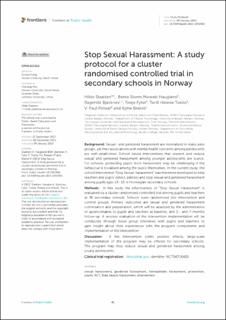| dc.contributor.author | Slåtten, Hilde | |
| dc.contributor.author | Haugland, Bente Storm Mowatt | |
| dc.contributor.author | Bjørknes, Ragnhild | |
| dc.contributor.author | Fyhn, Tonje | |
| dc.contributor.author | Tveito, Torill Helene | |
| dc.contributor.author | Poteat, V. Paul | |
| dc.contributor.author | Breivik, Kyrre | |
| dc.date.accessioned | 2024-02-02T11:26:50Z | |
| dc.date.available | 2024-02-02T11:26:50Z | |
| dc.date.created | 2023-02-18T13:16:23Z | |
| dc.date.issued | 2023 | |
| dc.identifier.citation | Frontiers in Public Health. 2023, 10 1-13. | en_US |
| dc.identifier.issn | 2296-2565 | |
| dc.identifier.uri | https://hdl.handle.net/11250/3115263 | |
| dc.description.abstract | Background: Sexual- and gendered harassment are normalised in many peer groups, yet their associations with mental health concerns among adolescents are well-established. School based interventions that prevent and reduce sexual and gendered harassment among younger adolescents are scarce. For schools, protecting pupils from harassment may be challenging if the behaviour is trivialised among the pupils themselves. In the current study, the school intervention “Stop Sexual Harassment” was therefore developed to help teachers and pupils detect, address and stop sexual and gendered harassment among pupils ages 13–15 in Norwegian secondary schools. Methods: In this study the effectiveness of “Stop Sexual Harassment” is evaluated via a cluster randomised controlled trial among pupils and teachers at 38 secondary schools. Schools were randomised into intervention and control groups. Primary outcomes are sexual and gendered harassment victimisation and perpetration, which will be assessed by the administration of questionnaires to pupils and teachers at baseline, and 2-, and 7-months follow-up. A process evaluation of the intervention implementation will be conducted through focus group interviews with pupils and teachers to gain insight about their experiences with the program components and implementation of the intervention. Discussion: If the intervention yields positive effects, large-scale implementation of the program may be offered for secondary schools. The program may thus reduce sexual and gendered harassment among young adolescents. | en_US |
| dc.description.abstract | Stop Sexual Harassment: A study protocol for a cluster randomised controlled trial in secondary schools in Norway | en_US |
| dc.language.iso | eng | en_US |
| dc.rights | Navngivelse 4.0 Internasjonal | * |
| dc.rights.uri | http://creativecommons.org/licenses/by/4.0/deed.no | * |
| dc.title | Stop Sexual Harassment: A study protocol for a cluster randomised controlled trial in secondary schools in Norway | en_US |
| dc.title.alternative | Stop Sexual Harassment: A study protocol for a cluster randomised controlled trial in secondary schools in Norway | en_US |
| dc.type | Peer reviewed | en_US |
| dc.type | Journal article | en_US |
| dc.rights.holder | © 2023 Slaatten, Haugland, Bjørknes, Fyhn, Tveito, Poteat and Breivik | en_US |
| dc.description.version | publishedVersion | en_US |
| cristin.ispublished | true | |
| cristin.fulltext | original | |
| cristin.qualitycode | 1 | |
| dc.identifier.doi | 10.3389/fpubh.2022.1051983 | |
| dc.identifier.cristin | 2127199 | |
| dc.source.journal | Frontiers in Public Health | en_US |
| dc.source.volume | 10 | en_US |
| dc.source.pagenumber | 1-13 | en_US |

